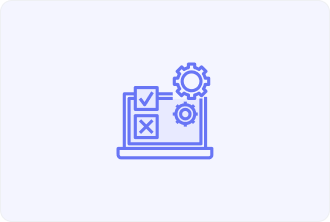Formative Testing Definition

Formative Testing — observing and data recording of the users’ interaction with a digital product to help get it off the ground with all required data. The metrics recorded assist businesses to conduct well-thought-out research during the testing phase and not dropping the ball when it comes to summative testing, there are a lot of such measurements and they tell everything about:
- Task success rate
- Error rate
- Time on task
- User satisfaction
- Observation notes
- Think-aloud feedback
- Number of hints or assistance requests
- Navigation path analysis
Such a method allows to define grey areas of the product operation and assesses data in product development cycle userstanding why something is not working properly, what issues can be detected, what insights about users behavior business can receive, etc. This term may be wrongly equated with Summative Testing however they are totally different since Formative Testing is used on the early stages of product development to identify possible issues.
It also is a starting point for new ideas, sparking features that really match what users want. This way of designing helps bring attention to accessibility issues that might not be obvious at first. Plus, it allows teams to dip their toes in the water and validate the core value proposition early on, making sure the product concept resonates before investing heavily in development.
Purpose of formative testing
Everything here is about catching possible problems with how users might experience a product before everything is finalized. It helps designers and developers see how real people actually use their interface — spotting where customers might find things tricky, get stuck or feel unsure and by actively seeking feedback through continuous loops, teams can make swift adjustments, ensuring the product develops alongside user expectations and practical goals.
This approach isn’t just about fixing problems it’s about creating a solid foundation so everything runs smoothly from the start. It provides stakeholders with the ability to cut through the noise, enabling them to make confident choices based on real-world actions instead of wishful thinking so the main point of formative testing is to take your gut feelings and turn them into solid data since it helps early ideas grow and stay on the right track.
It helps different teams work together better by providing clear, practical information that everyone can use to make better choices.
Role of formative testing in the product development process
Think of formative testing like a reliable map that helps teams navigate the rough patches when developing a new digital good. It nurtures a mindset of experimentation, encouraging squads to throw ideas at the wall and see what sticks, rather than being overly cautious about failing.
This technique is designed to help work flexibly, where fast changes and quick feedback are key to staying on top of things. Unlike fast looking through that happens at the final moment, formative testing is woven into the entire process, acting as a dependable ally instead of a last-minute checkpoint.
It becomes the perspective through which usability is continuously refined, revealing user intentions, mental barriers and emotional cues as the product starts to develop its own identity. It also simplifies team collaboration by providing relevant, user-focused data that supports better decision-making across different departments.